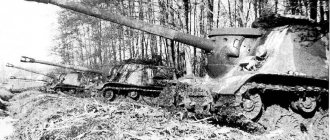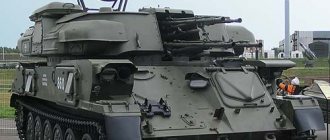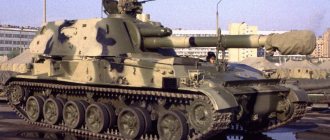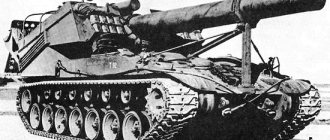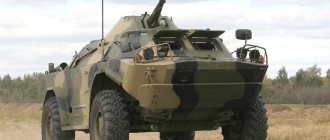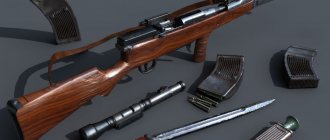The German “Goliath” from the Second World War is the most widespread, widely known and recognizable tracked self-propelled mine
Tracked torpedo "Goliath" Sd.Kfz.303a (vehicle version equipped with a gasoline engine) close-up
Self-propelled mine
(
tracked torpedo
,
wedge torpedo
) - a type of anti-tank weapon with non-directional high-explosive action[sn 1][1]. Currently not applicable.
Structurally, it is a small unarmed unmanned tracked vehicle, similar to a wedge, controlled remotely and carrying an explosive charge sufficient to penetrate tank armor. The power plant may have one or more electric motors or an internal combustion engine. Used from a shelter, controlled by one operator via wire or radio signal; detonation is carried out by the operator’s command or when an enemy vehicle collides. You can defuse a mine by shooting after unmasking, or, in the case of control by wires, by cutting them[1].
Description
This tracked vehicle had approximate dimensions: 150x85x56 cm. The design carried 75-100 kg of explosives and was intended to destroy tanks, dense infantry formations and destroy buildings.
"Goliath" was disposable, as it was intended to self-destruct. At first the Goliaths used an electric motor, but since they were expensive (3,000 Reichsmarks) and difficult to repair, later models (known as the SdKfz. 303) used a simpler and more reliable 12 hp petrol engine. Although a total of 7,564 Goliaths were produced, the weapon was not considered a success due to its high cost, low speed (9.5 km/h), low maneuverability, vulnerable wires and thin armor (10 mm), which was unable to protect the self-propelled mine from any form of anti-tank weapons. Late model Goliaths cost approximately 1,000 Reichsmarks (Sd.Kfz. 302 approximately 3,000 Reichsmarks) - for comparison, the 75 mm Pak 40 anti-tank gun cost 12,000 Reichsmarks. SdKfz.
303 , Goliath design with references to individual structural groups.
In popular culture
- In the famous wargame Warhammer 40,000, the Imperial Guard faction has the ability to use a Cyclops tracked mine, controlled via a radio signal from a control vehicle (a converted Chimera infantry fighting vehicle)[6]. The characteristics of the vehicle and its use in the game are extremely conditional, but in general terms they repeat those of real self-propelled mines.
- In the cinema, a tracked mine (German “Goliath”) can be seen in the second film of Yuri Ozerov’s epic “Soldiers of Freedom”, mostly dedicated to the uprising in Warsaw.
Application
The Goliath was used by the German army during World War II (notably to destroy barricades during the Warsaw Uprising).
“Goliaths” were first used against the Red Army in the summer of 1943 during the battle on the Kursk Bulge [1]. Subsequently, one of the captured Goliaths was transferred to the permanent exhibition of captured weapons in Moscow organized in 1943 (exhibited under the name “ German torpedo wedge for fighting tanks
")[2]. Since the beginning of 1945, the intensity of their use has increased[3].
| This section is not completed. You will help the project by correcting and expanding it. |
Notes
Footnotes
- In early projects of self-propelled mines, they were supposed to be used primarily to break through enemy fortifications.
Sources
- ↑ 1 2 3 4 Antonov A. S., Artamonov B. A., Korobkov B. M., Magidovich E. I.
Tracked torpedo // Tank. - M.: Voenizdat, 1954. - P. 315-316. — 607 p. - Torpille Terrestre. Encyclopedia of aviation and armored vehicles Aviarmor. Retrieved June 12, 2011. Archived August 1, 2012.
- Type 98 "I-I-Go". Encyclopedia of aviation and armored vehicles Aviarmor. Retrieved June 12, 2011. Archived August 1, 2012.
- Vehicules P. Encyclopedia of aviation and armored vehicles Aviarmor. Retrieved June 12, 2011. Archived August 1, 2012.
- Engin K. Encyclopedia of aviation and armored vehicles Aviarmor. Retrieved June 12, 2011. Archived August 1, 2012.
- Cyclops demolition vehicle (English). Forge World. Retrieved May 25, 2011. Archived August 1, 2012.
TTX
| "Goliath E" Sd.Kfz. 302 "Gerät 67" | "Goliath V" | ||
| Sd.Kfz. 303a "Gerät 671" | Sd.Kfz. 303b "Gerät 672" | ||
| Total information | |||
| Manufacturers | Borgward | Borgward, Zündapp & Zachertz | |
| Year of production | April 1942 - January 1944 | April 1943 - September 1944 | from November 1944 |
| Quantity | 2650 | 4604 | 325 |
| Price | ~3000 | ~1000RM | |
| TTX | |||
| Weight | 370 | 365 kg | 430 kg |
| Explosives | 60 kg | 75 kg | 100 kg |
| Length Width Height | 1.50 / 0.85 m / 0.56 m | 1.62 m / 0.84 m / 0.60 m | 1.63 m / 0.91 m / 0.62 m |
| Drive unit | 2 electric motors 2.5 kW each (Bosch MM/RQL 2500/24 RL2) | 2-cylinder two-stroke engine; 703 cm³ / 4500/min, 12.5 l. With. (Zündapp SZ7) | |
| Speed | 10 km/h | 11.5 km/h | |
| Fuel | not applicable | 6 | |
| Radius of action | 0,8—1,5 | 6-12 km (6-8 km off-road) | |
| Clearance | 11.4 cm | 16 cm | 16.8 cm |
| Moat[ clarify ] | 60 cm | 85 cm | 100 cm |
| Armor (front) | 5 steel | 10 mm steel | |
Unmanned multi-purpose vehicles designed to perform various auxiliary functions in war conditions (be it undermining enemy targets, engineering work or reconnaissance) appeared back in the 1910s. Many people have experimented with this technique.
The era of experiments with combat television machines 1910s - 1930s.
So, in 1915, the French developed the Torpille Terrestre wedge to undermine enemy targets. The unmanned Torpille Terrestre was controlled by an operator using a wired communication line and was blown up at the right moment. And even earlier, in 1909, the Frenchman Gustav Gabe successfully tested a radio-controlled torpedo to destroy surface targets, but due to some shortcomings and high cost, his brainchild never entered service with the army.
French experimental uncrewed teletankette Torpille Terrestre (1915)
The Americans also had similar developments. In 1918, engineer Elmer Wickersham developed an electrically powered teletankette. In 1922, E. Wickersham received a patent for his invention, but this machine never went into production. The matter stopped at the production of prototypes. Later, remote-controlled unmanned equipment appeared in the Soviet Union and Japan. In the USSR, experiments with uninhabited military equipment began in 1929 and continued throughout the 1930s.
Elmer Wickersham's electric teletankette (USA, 1918)
Then the Soviets had a whole line of experimental unmanned tanks: type M (1929), TT-18 (1929), TT-27 (1932), XTT-26 (1932), TT-26 (1933 g.), TT-20, TU-20, TT-38 (1935). And this is not a complete list of Soviet teletanks. Some of them had a chance to participate in real battles. In Japan, in 1929, the experimental Nagayama teletank was built, and in 1937, the “demolition teletank” (Type 98).
Japanese radio tank "Nagayama" (1929)
Between the First and Second World Wars, this topic aroused the interest of many. Germany was no exception and, of course, did not stand aside. German engineers began actively experimenting with “combat television machines” in the late 1930s. It bore fruit. By 1942, several types of unmanned combat tankettes had appeared: from the most modest 400-kilogram Goliath to the 5-ton B-IV. Within the framework of this material, only the most famous and widespread machines of this type will be considered - “Goliaths”.
"Goliaths" - the first large-scale television machines
According to the Wehrmacht's internal classification system, the remote-controlled Goliath wedges bore the indices Sd.Kfz 302, 303a, 303b. Sd.Kfz – Sonder Kraftfahrzeug, which means special vehicle.
Engine K Kegress - a promising French wedge that served as a prototype for the German Goliath
"Goliath" was created on the basis of the French prototype Engin K Kegress. The prototype Engin K in the spring of 1940 had already passed all tests, was almost ready for mass production, and was sunk by the French in the Seine River during the German army's invasion of France. The Germans lifted the prototype from the bottom of the river and sent it for study to the German plant, which since the late 1930s. conducted research in the field of remote-controlled mechanisms for the needs of the army. Borgward specialists disassembled the French car and carefully examined it. Based on French developments, they created their own teletankette, which the Germans managed to put on the assembly line and set up mass production. It is worth noting that before 1942 no one in the world had done this. Thus, Goliath became a pioneer in this field - the first mass-produced television machine.
Design and operating principle of the first model Sd.Kfz.302 (E-Motor)
Sd.Kfz.302 was a small tracked wedge. The dimensions of the vehicle body were 1.5 x 0.85 x 0.56, the weight without explosive charge was 310 kg. The body was made of 5 mm thick steel and was divided into three compartments. In the rear compartment there was a reel with a three-core cable (two for control, one for detonation), in the middle there were control devices and mechanisms, in the front there was a container with explosives. On the sides between the large rollers, covered with lids, were Bosch electric motors and batteries (24V voltage, total capacity 100 Ah). Two electric motors with a total power of 5 kW (one on each side) transmitted torque through gearboxes to the driving front wheels, thus driving the caterpillar track.
The Goliath was controlled by an operator from a shelter at a distance using a remote control connected to the machine via a cable (about 700 m long). There were two levers on the remote control: at the top right there was a lever for turning the car left or right; at the top left is a lever with three positions to control movement (forward, stop and reverse). The explosion was carried out by turning a key, which was inserted into a hole on the remote control located below the motion control lever. Maneuvering with the help of the remote control levers, the operator detonated the wedge at the right moment, thereby destroying the enemy object (along with the wedge).
The wedge model Sd.Kfz.302 (E-Motor) could carry an explosive charge weighing up to 60 kg and move at speeds of up to 10 km/h. The 302's cross-country ability left much to be desired; one of the reasons was the low ground clearance and weak engines. The power reserve was only 1.5 km, but this is ideal; in reality, it rarely exceeded 1 km, because In off-road conditions, the batteries drained quickly. Another drawback of the Model 302 wedges was insufficient protection from bullets. The body could easily be penetrated by a machine gun or rifle, not to mention more powerful weapons.
Despite the obvious shortcomings and high cost (3,000 Reichsmarks), the car was nevertheless put into mass production. The first copies were manufactured in April 1942. In total (until January 1944) 2,650 copies of the Sd.Kfz.302 were produced (they were also designated Gerät 67, which translates as product 67). The developers took into account many of the shortcomings of the 302nd model and tried to eliminate them in the next model - Sd.Kfz.303.
Petrol version "Goliath V" Sonder Kraftfahrzeug Sd.Kfz.303a/303b (Gerät 671, 672)
In an effort to reduce the cost of Goliath self-propelled mines, in 1943 German engineers made a number of changes in the design of the machines, after which it received the index Sd.Kfz.303a (or Gerät 671). First of all, this affected the power plant; the electric motor was replaced with a cheaper and simpler gasoline engine. The Zündapp SZ7 two-cylinder carburetor engine had a displacement of 0.7 liters and developed a power of 12 hp. It was located in the middle compartment of the wedge body. Gasoline was poured into a 6-liter fuel tank, which was placed in the rear compartment between the wire reel and the middle compartment. This made it possible to increase the power reserve from 0.8-1.5 km to 6-12 km.
The battery was placed on the side and covered with a lid, next to it were the air filter and control mechanisms. The body of the modernized Goliath remained almost unchanged in size (1.62 x 0.84 x 0.60 m), but received more powerful protection, now the wall thickness was 10 mm. On the outside, it has also undergone some changes, albeit subtle ones. Despite the doubled armor, the weight of the 303rd even decreased (apparently they got rid of heavy batteries for electric motors) to 290 kg (versus 310 kg for the 302nd model). This made it possible to increase the mass of the explosive charge by 15 kg - up to 75 kg, which significantly added destructive power.
Changes in the design made it possible to significantly increase the ground clearance: from 11.4 cm to 16.0 cm. Thanks to this, the off-road patency of the Goliath 303a was improved. The depth of the ditch to be overcome was 85 cm (versus 60). The maximum speed of the 303 remained the same - 10 km/h. As you can see, significant changes have taken place, which has made it possible to significantly improve the tactical and technical characteristics of the Goliath wedges of the 303rd model. But most importantly, we managed to reduce the cost by three times - from 3,000 to 1,000 marks.
From April 1943 to September 1944, 4,604 model 303a gasoline wedges were produced (at the factories of Borgward, Zündapp & Zachertz). The next and last modernization was carried out in 1944. The model received the index 303b (Gerät 672). The car has increased in size and weight: 1.63 x 0.91 x 0.62 m and 330 kg. The maximum speed has increased to 12 km/h. The mass of the explosive charge reached 100 kg. The ground clearance was raised to 16.8 cm, and the depth of the ditch to be overcome increased to 100 cm. A total of 325 Goliaths 303b were produced.
Using Goliaths
The first units to receive Goliaths were the 811th and 815th tank engineering companies, as well as the 600th motorized battalion. Later, the teletankettes entered the 627th Engineer Assault Brigade.
In real combat, the Germans first used Sd.Kfz.302/303 self-propelled mines in July 1943 during the offensive Operation Citadel. Then all the latest weapons of the Wehrmacht were used: the latest medium tanks Pz-V (Panther), heavy tanks Pz-VI (Tiger), heavy self-propelled guns "Ferdinand". Together with these heavyweights, teletankettes also received a baptism of fire. They were part of the 654th tank destroyer division, which had 44 Ferdinands at the start of the operation. The division was operationally subordinate to the 41st Tank Corps and fought on the northern front of the Kursk Bulge in the area of Ponyry station, where it suffered heavy losses. Most of the Ferdinands were disabled (mainly in minefields).
It is not known exactly how the Goliath self-propelled mines performed. The fact that they were used can be judged from reports to the General Staff of the Red Army. The report recorded cases of the Germans using a new type of weapon - small tracked unmanned vehicles with explosives on board. The vehicles attacked Soviet tanks, exploding next to them, damaging them and putting them out of action. It was also noted that the German tankettes (the Russians called them torpedo tankettes) attacked and destroyed the fortifications of the Red Army.
It is difficult to say how successful the use of “Goliaths” was, but it can be assumed that they still showed some results. How else can we explain the fact that in July 1943, a reconnaissance group (which included armored engineers) was sent to the Central Front with the goal of capturing torpedo tankettes for further study and development of measures to combat them. Soviet specialists identified a number of shortcomings of German teletankettes, including insufficient maneuverability and poor protection. Based on this, recommendations were developed for their destruction: breaking the cable, shooting with all types of weapons, burning with a Molotov cocktail, and blowing up with a grenade. Tankers were strictly forbidden to run over tankettes and keep a distance from them.
American sappers inspect the Goliaths (SdKfz 302) captured in Normandy
"Goliaths" were considered by the Soviet side as a modern and dangerous weapon that could cause significant damage if countermeasures were not taken in time. In addition to the Eastern Front, the Germans also used teletankettes against American and British troops. Evidence of this is numerous photographs of the Allies with captured Goliaths.
hiswar.net
